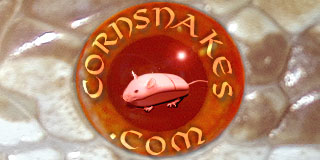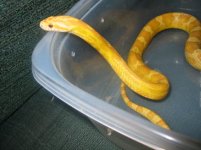This came up recently and seems to be a question quite frequently with new comers to the hobby trying to find out what morph of snake they have. Since I had the pictures cropped anyway, I thought I'd post them here.
The pupil is the central color of the eye (see photo). The pupil is the "window" into the back of the eye and the color you see there is a reflection from the back of the eye. The curtain that closes off most of the eye to light is the iris (see photo). This acts to regulate how much light enters the eye to strike the retina. You'll notice that the iris is huge and the pupil tiny when the snake's eyes are submitted to bright light (like sunlight). If you want the best look at an iris, bright light is the key, because the pupil is constricted. If you want the best look at the pupil, keeping the snake in dim light will increase the pupil's size.

The difference in coloration of the pupil comes from the amount of pigmentation at the back of the eye (in the retina). A normal snake's retina is heavily pigmented to absorb light to reduce light bouncing around and being "read" by the retina multiple times, hindering sight. In some morphs, melanin (the dark pigment) is reduced and if enough is removed, the pupil may glow a ruby red in good light. (see photo below of the hypo lavender) This is caused by the reflection of light through blood vessels/tissue giving the red hue with enough dark pigment remaining to darken the color from the red pupil of an amel to the ruby of some hypo and lavender type morphs. Amels do have red pupils, the reason, obviously is the lack of black pigment in the back of the eye. Since no light is absorbed by melanin, it passes through tissue and some gets reflected back. Reflection back through blood vessels lends the red glow to the pupil.

When someone asks "does the snake have red or black eyes", they are asking the color of the pupil most of the time. This is the big determiner of amelanism in a snake with no visible black pigment in its pattern (vs. an extreme hypomelanistic type snake that still has black or ruby pupils).
The pupil is the central color of the eye (see photo). The pupil is the "window" into the back of the eye and the color you see there is a reflection from the back of the eye. The curtain that closes off most of the eye to light is the iris (see photo). This acts to regulate how much light enters the eye to strike the retina. You'll notice that the iris is huge and the pupil tiny when the snake's eyes are submitted to bright light (like sunlight). If you want the best look at an iris, bright light is the key, because the pupil is constricted. If you want the best look at the pupil, keeping the snake in dim light will increase the pupil's size.

The difference in coloration of the pupil comes from the amount of pigmentation at the back of the eye (in the retina). A normal snake's retina is heavily pigmented to absorb light to reduce light bouncing around and being "read" by the retina multiple times, hindering sight. In some morphs, melanin (the dark pigment) is reduced and if enough is removed, the pupil may glow a ruby red in good light. (see photo below of the hypo lavender) This is caused by the reflection of light through blood vessels/tissue giving the red hue with enough dark pigment remaining to darken the color from the red pupil of an amel to the ruby of some hypo and lavender type morphs. Amels do have red pupils, the reason, obviously is the lack of black pigment in the back of the eye. Since no light is absorbed by melanin, it passes through tissue and some gets reflected back. Reflection back through blood vessels lends the red glow to the pupil.

When someone asks "does the snake have red or black eyes", they are asking the color of the pupil most of the time. This is the big determiner of amelanism in a snake with no visible black pigment in its pattern (vs. an extreme hypomelanistic type snake that still has black or ruby pupils).

